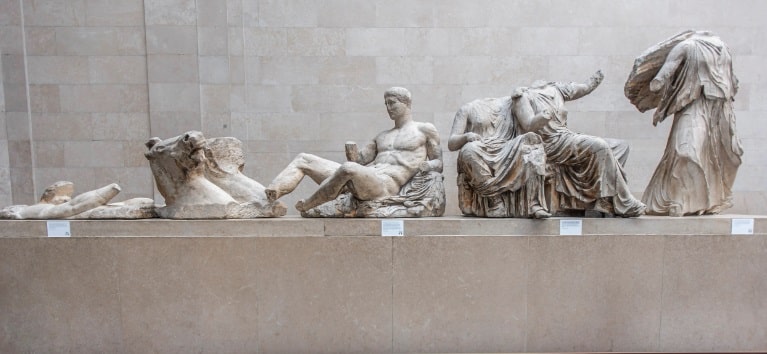What’s in today’s article?
- Why in news?
- Parthenon Sculptures
- What are the Parthenon Sculptures?
- How did the sculptures reach Britain?
- Were the sculptures stolen?
- How did Britain respond?
Why in news?
- Recently, British PM Rishi Sunak cancelled a meeting with his Greek counterpart Kyriakos Mitsotakis over the status of the Parthenon Sculptures housed at the British Museum.
- It prompted Athens to accuse London of trying to avoid discussing the contested sculptures, also known as the Elgin Marbles.
- Over the years, Greece has repeatedly asked for the sculptures’ permanent return to Athens, but the British Museum have refused to do so.
What are the Parthenon Sculptures?
- About
- The Parthenon Sculptures at the British Museum are more than 30 ancient stone sculptures from Greece that are more than 2,000 years old.
- Most of them originally adorned the walls and grounds of the Parthenon temple on the rocky Acropolis hill in Athens.
- Completed in 432 BC, the temple is dedicated to the goddess Athena and is seen as the crowning glory of Athens’ Golden Age.
- Made between 447BC and 432BC they consist of:
- a frieze which shows the procession of the Panathenaic festival (the commemoration of the birthday of the goddess Athena);
- a series of metopes (sculpted relief panels) depicting the battle between Centaurs and Lapiths at the marriage-feast of Peirithoos; and
- figures of the gods and legendary heroes from the temple’s pediments.
- The Parthenon Sculptures at the British Museum are more than 30 ancient stone sculptures from Greece that are more than 2,000 years old.
- History of Parthenon
- The Parthenon was constructed in the 5th century BC, reflecting the power and dominance of the then city-state of Athens.
- It became a symbol for the modern nation state of Greece following independence from the Ottoman Empire in 1832.
- When Athens was selected as capital of the new country in 1834, most of the post-Roman period structures on the Acropolis were removed.
- This was to accommodate further archaeological exploration and to return the site to a state that reflected Greece’s idealised ‘Classical’ past.
- The Parthenon itself has a complex history. It has been a temple, a church, a mosque and is now an archaeological site.
- It has sustained significant damage throughout its long history, in particular as a result of an explosion while it was in use as an ammunition store in 1687; this left the Parthenon as a ruin.
- The Architecture of the Parthenon
- For ancient Greeks, mathematical ratios formed the basis of ideal standards such as harmony, beauty, and balance.
- Thus, their architectural styles reflect these mathematical ratios.
- The Parthenon was designed and built in the Doric style, while also incorporating some Ionic elements.
- Doric architecture features fluted columns without bases, topped with simple capitals, or tops, that are rectangular.
How did the sculptures reach Britain?
- They were removed from the Parthenon in the early 19th century by Thomas Bruce, the 7th Earl of Elgin and then-British ambassador to the Ottoman Empire.
- The marbles were taken to Britain and purchased by the British Museum in 1816.
Were the sculptures stolen?
- While Athen accused Lord Elgin of theft, he insisted he had permission to remove the marbles from the Ottoman Empire, which used to control Athen at the time.
- The original letter giving him permission, however, has been lost and its text remains disputed.
- Athens has been demanding the return of the sculptures since it became independent in the early 1830s.
- The campaign gained momentum in the 1980s after Greek Oscar-nominated actress Melina Mercouri launched a movement for their return when she was culture minister between 1981 and 1989.
How did Britain respond?
- The British Museum, the caretaker of the sculptures, claims that they were acquired by Elgin under a legal contract with the Ottoman Empire.
- Hence, it has rejected the demands of their return.
- In March, PM Sunak said the marbles are a huge asset to the UK and ruled out changing a law that would allow the sculptures to be given back to Greece.
Q1) Who is goddess Athena?
In ancient Greek mythology, Athena was the goddess of wisdom, war, and crafts. She was also the patroness of Athens.
Q2) What is Doric style of architecture?
The Doric style is a simple, geometric, and monumental style of architecture that originated in mainland Greece.
Source: What are the Parthenon Sculptures, at the centre of the row between Britain and Greece? | The British Museum
Last updated on June, 2025
→ UPSC Notification 2025 was released on 22nd January 2025.
→ UPSC Prelims Result 2025 is out now for the CSE held on 25 May 2025.
→ UPSC Prelims Question Paper 2025 and Unofficial Prelims Answer Key 2025 are available now.
→ UPSC Calendar 2026 is released on 15th May, 2025.
→ The UPSC Vacancy 2025 were released 1129, out of which 979 were for UPSC CSE and remaining 150 are for UPSC IFoS.
→ UPSC Mains 2025 will be conducted on 22nd August 2025.
→ UPSC Prelims 2026 will be conducted on 24th May, 2026 & UPSC Mains 2026 will be conducted on 21st August 2026.
→ The UPSC Selection Process is of 3 stages-Prelims, Mains and Interview.
→ UPSC Result 2024 is released with latest UPSC Marksheet 2024. Check Now!
→ UPSC Toppers List 2024 is released now. Shakti Dubey is UPSC AIR 1 2024 Topper.
→ Also check Best IAS Coaching in Delhi
























